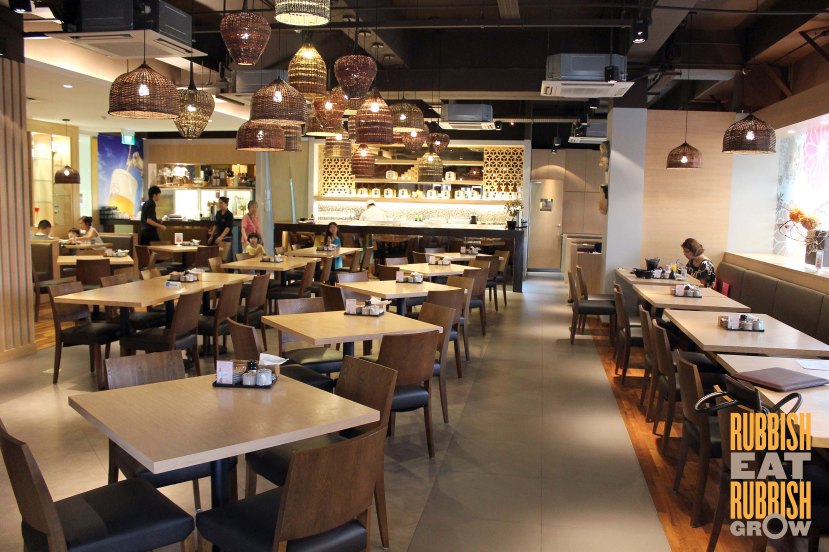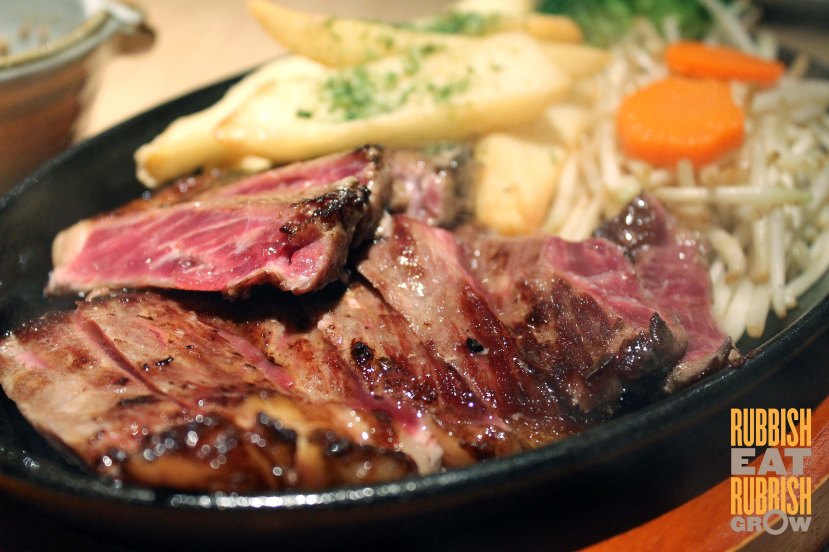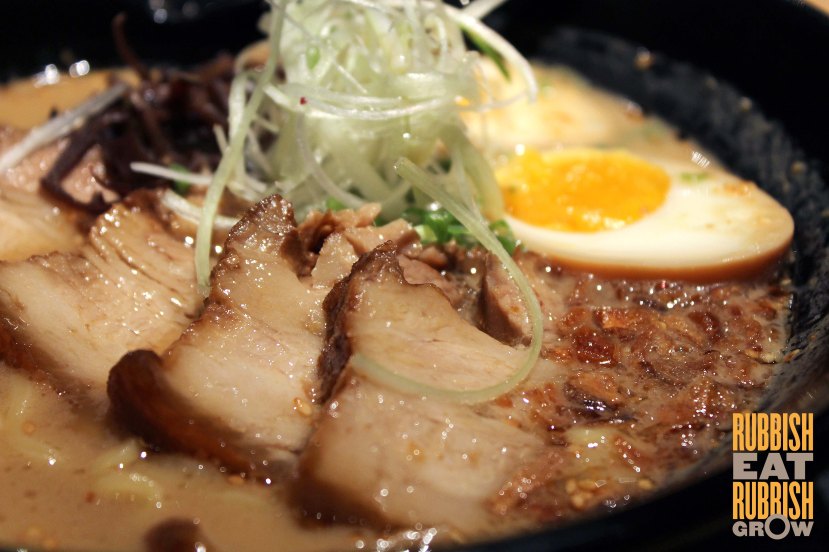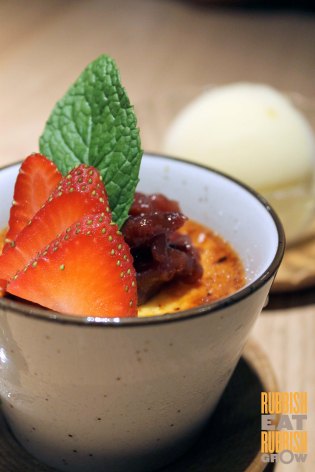
If you grew up in Ang Mo Kio, you’d know that this building, Broadway, used to be a cinema. Now it has gentrified, don’t be fooled by the classy interior of the restaurant. The prices here are wallet-friendly.

Premium Sashimi Moriawasa for 2 ($45)
The Japanese-owned restaurant is large with 120 seats and 2 VIP rooms. Equally expansive is the offering of 150 dishes so it is not surprising to find that “Marugoto” means “to eat an entire meal” but we think you can eat a lifetime of meals here. Home-grown Chef Quek Weili, who has worked at Japanese fine dining restaurants in Singapore such as Nogawa Sushi, Aoki, and Takumi, helms the kitchen, assisted by a ramen chef who has worked at the defunct Noodle House Ken.
 The restaurant tries to get the best quality ingredients at the price that we are paying. Many of the meat and fish are marinated with shiokoji, salted fermented rice, a traditional Japanese seasoning that gives the umami taste.
The restaurant tries to get the best quality ingredients at the price that we are paying. Many of the meat and fish are marinated with shiokoji, salted fermented rice, a traditional Japanese seasoning that gives the umami taste.
For a few starters, the premium sashimi moriawasa (for 2, $45) came beautifully plated but we were there on a Monday and since fish are usually delivered on Tuesdays and Fridays, the sashimi wasn’t as fresh as they could be. The thinly sliced beef carpaccio ($25), Australian wagyu with a marbling of 7-8, came lightly poached, drizzled with fragrant truffle oil and specked with black pepper. Oily but very smooth and tender. This was Chiobu’s favorite starter. I preferred the gyoza (pictured above, $5.90), made with kurobuta black pork, with a very delicate skin, although Chiobu remarked that it could be crispier and the filling could be more substantial.

For the mains, the tonkatsu ($13.90, additional $4.90 for rice, salad and dessert) uses fresh bread crumbs or in Japanese, nama panko, which made it crispier than usual and, Chiobu commented, the pork was less dry than elsewhere. The very reasonably priced wagyu wafu steak ($17.90) arrived sizzling and was tender in parts that were raw, Chiobu’s favorite parts, but tougher at the edges. The best way was to remove from the heat quickly when you deem it cook the way you like.

Out of the three mains, my favorite was the Tokyo shoyu ramen ($15.90), with lip-smacking collagen and salt in the broth–Chiobu found it too salty but I loved it–springy noodles and pork so gelatinous it dissolved in the mouth. The egg could be improved, too hardboiled.
 To round things off, we had cream brulee ($4.90), which unfortunately proved the adage that Japanese has no good desserts true. Too eggy and not light enough for our liking.
To round things off, we had cream brulee ($4.90), which unfortunately proved the adage that Japanese has no good desserts true. Too eggy and not light enough for our liking.
Our conclusion is although the food is nothing to shout about, it is wide-ranging and decent at an affordable price, in a great ambience. Good for families, large group, and even dates.
Marugoto Shokudou
4190 Ang Mo Kio Ave 6
Broadway Plaza
#01-07
Singapore 569841
T: 6451 2822
1130am-2230pm
(closed for lunch on Mon)
Rating: 3.063/5 stars
PS: Thanks Andy and Weili for the invite.
Written by A. Nathanael Ho.
Categories: $0-$20, $20-$40, Ang Mo Kio, Dates, Japanese, Large Group

do they really have no good desserts? the japanese, I mean – I’ve always thought things like tofu pudding and mochi with tsubian disarmingly good in their simplicity
LikeLike
tsubu-an*
LikeLike
It’s a common saying among experienced food writers in overseas newspapers that I follow. They also say Italians have no good desserts. I think their idea of good desserts is that it must be intricate, careful, sublime requiring a million steps, like French desserts.
Mochi is divine! But it’s more like a snack and doesn’t stand up to the French Test. Neither does tofu pudding.
LikeLike
yes I’ve seen that about italians too – but when written about asians I mostly strike it off as an inept inability to conceive of anything rather different from their expectations of a layered moussey something. I scoff at french desserts – they’re pretty to look at, but I much rather like stuffing my face with sort of homely pud (which means british/japanese/italian) – and probably proves my taste more proletariat than theirs (:
LikeLike
You’re right, people should have different standards for different cuisines because the food a society produces is dependent on the culture. Complexity shouldn’t be the golden rule across the board. Japanese value zen, lightness, simplicity, and maybe that should be the criteria to judge Japanese desserts.
That being said, seldom do people say “I look forward to dessert” in a Japanese restaurant but people say that in European ones.
LikeLike
Yes, Japanese restaurants do not really serve amazing desserts. But if you go to a specifically dessert cafe, they are usually good! Well, only if you appreciate Asian > European style…
LikeLike
Oh yes. Japanese cakes are awesome.
LikeLike
oh yes, looks like another restaurant worth visiting at AMK. How would they rank against Santouka and tampopo?
LikeLike
If you’re talking about ramen, i don’t like santouka and tampopo leh. I prefer marutama, and the 3 Keisuke shops.
LikeLike
I saw this restaurant in Restaurant Week… and wondered if AMK residents would support this. Prices seem reasonable though.
LikeLike
It was about 75% packed when I was there. But they really need the lunch crowd. Hard to sell lunch coz there isn’t many offices nearby.
LikeLike